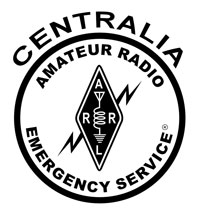 Perhaps a new mission for Centralia ARES, perhaps just a good training exercise, only time will tell. In recent years, localized wildfires have plagued the regions around Centralia but thankfully, the larger fires have missed our area. When Riverside Fire Chief Mike Kytta asked how the Centralia ARES team could help during a large wildfire, the list included nine areas including windshield surveys around the outside of the fire area looking for hotspots, help with evacuations and, of course, communications.
Perhaps a new mission for Centralia ARES, perhaps just a good training exercise, only time will tell. In recent years, localized wildfires have plagued the regions around Centralia but thankfully, the larger fires have missed our area. When Riverside Fire Chief Mike Kytta asked how the Centralia ARES team could help during a large wildfire, the list included nine areas including windshield surveys around the outside of the fire area looking for hotspots, help with evacuations and, of course, communications.
The dynamics of helping with a wildfire response are complicated. When the call for help occurs, there isn’t time to do long term training to be ready. The training has to come before the call as the response time must be immediate. With the training comes the responsibility to keep everyone on the team safe, often in an area of heavy smoke. Add the panic of an evacuation into the mix and confusion reigns supreme,
Will all this in mind, the ARES team conducted its first wildfire training exercise last evening. The pretend wildfire was located just outside the Centralia industrial park. Between the fire and the small town of Galvin is the Chehalis River. While this might seem a good fire break, high winds and plenty of fuel in the dry hayfields, could easily allow a floating ember to cross the river starting a new fire area, thereby threatening Galvin. The area also contained a storage area for empty oil railroad tank cars, an electrical substation and a propane distribution center.
Gathering at a staging area for a situation briefing, a safety briefing and assignments, team members deployed to the area. We placed one communications vehicle, Comm II, on one side of the river nearest the wildfire and the other van, Comm III, across the river in Galvin. Team leaders in the vans had to choose a safe location to set up, establish windshield survey patrol areas and assign someone to determine all possible evacuation routes. Windshield survey teams were to fan out looking for smoke in areas where it shouldn’t be and watching for small spot fires. Additionally, they were to identify potential dangers such as the railroad tank cars and notify their respective comm vans of their location. The evacuation team’s job, besides determining evacuation routes, was to gather an estimate of homes within the danger area should the wildfire move to the west. Team leaders and radio personnel in the communications vans were responsible for keeping track of the windshield survey teams and knowing where they were at all times.
After a little over 90 minutes, we shut down the exercise and met for a debriefing. Most of our training exercises follow a simple system which involves planning the exercise, testing our plan in the field, figuring out what went right and what went wrong, and finally, fixing the problems. As exercises go, the wildfire exercise went smoothly, which is a credit to our team as even the new team members did well. As always, it is often the little things that need fixing. Many of the team forgot to bring water even though the temperatures have been in the 90’s for days. No one spotted or reported the railroad tank cars and we discovered we couldn’t depend on the HT’s being used in the field as not being heard is a safety problem. On the plus side, evacuation routes were established quickly, dangerous areas and choke points were identified and communications was tight and done professionally. We all learned something from this exercise. The team will need to get better at its mapwork and will learn to deploy the field team quicker. We realize now that windshield surveys shouldn’t be difficult as long as we keep safety in mind but if called upon to help with or perform evacuations, it will be quite a different story, but that training will need to wait until August.
While the ARES team doesn’t yet know if we will be called upon to respond to help our served agency with a wildfire, we fully understand that training for the event ahead of time is the only way to keep everyone safe and prepared. We’re already planning several more wildfire training exercises to increase our proficiency in a few areas. Now, we’ll see how the summer goes.

